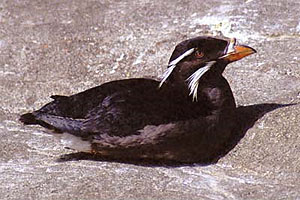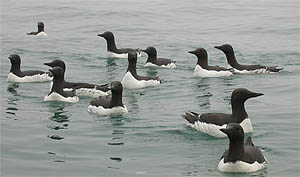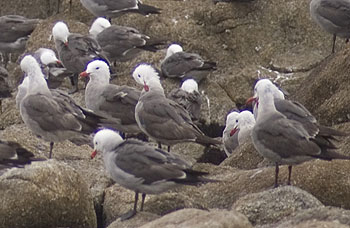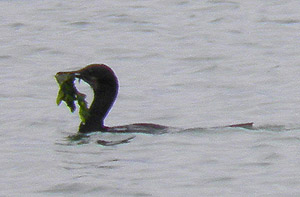
|
|||||||||||||||
|
| |||||||||||||||
Bad weather but good bird watching January may not bring very good bird-watching weather, but it is a good time of year to see a variety of wetland and sea birds. Many seabirds spend their winters enjoying the relatively mild climate and reliable food supply of areas such as Monterey Bay. Some are fattening up before leaving the area to breed (in April). During January and February, most of these birds are wearing their winter (non-breeding season) plumage, which is usually rather dull and unobtrusive. By late February or March, however, the coloration of some male birds (e.g. loons) will start to become more dramatic, as their breeding plumage grows in. Open-ocean birds appear near shore Just as any winter blooms of marine algae tend to congregate near shore, so do that larger forms of life, including anchovies and seabirds. During January storms, red phalaropes, ancient murrelets, and other open-ocean birds are often carried from their normal offshore habitat into sheltered near-shore waters. Farther offshore, January boaters on Monterey Bay or in the Gulf of the Farallones may be treated to the sight of a Laysan albatross banking over the swells like a sailplane. A rare but fascinating avian visitor to the Central Coast in winter is the short-tailed shearwater (Puffinus tenuirostris). Most of these birds live around Australia and spend October through April nesting in the southern hemisphere. But a few intrepid birds migrate to feed in the Bering Sea in the fall, and then fly down along the Central Coast during the winter time before heading back to Australia. They sometimes join flocks of sooty shearwaters, which are another rare winter visitor to Monterey Bay (but are extremely numerous in summer/fall). Auklets  Rhinoceros auklet (Source: G.K. Peck / Environment Canada) January is also the best time of year to see rhinoceros auklets and Cassin's auklets, two other small birds that spend most of their time on the open ocean. During winter, these birds migrate toward shore to forage in kelp beds and protected nearshore waters such as Monterey Bay. Auklets float very low in the water, and are often hard to see or identify from shore. Rhinoceros auklets are the larger of the two birds, reaching the size of small ducks, and have a distinctive "horn" on their bills. Cassin's auklets are robin-sized birds, with slate- to light-gray wings and white bellies, as well as distinctive white spots just below their mouths. They are so small that when they come close to shore they run the risk of being attacked and eaten by western gulls. You can often see pairs of auklets swimming companionably together, rising and falling with the swells, and maintaining a domestic air that provides a striking contrast to the vast, sometimes stormy open ocean around them. Somehow these pairs stay together through storms and migrations that may encompass hundreds of miles of trackless ocean. Most of the year, the auklets hunt krill, foraging widely across the continental shelf. In April, the auklets leave the coast to spend their time nesting at the Farallon Islands (and to a lesser extent at Ano Nuevo). Recent studies have shown that early upwelling events in February or March provide a little extra food that allows auklets and murres get an early start on nesting. This, in turn, which makes it more likely that their young will survive. Murres  Common murres (Source: NOAA / PMEL) Thousands of common murres (Uria aalge) also gather in the sheltered waters of Monterey Bay and the inner Gulf of the Farallones during winter, to feed and fatten up for the spring nesting season. In the outer parts of Monterey Bay, individual murres sometimes dot the surface of the ocean as far as the eye can see, with individual birds keeping a distance about 20 to 30 feet apart. Others swim together in pairs, in anticipation of the spring mating season. When startled by a boat, murres flap their wings rapidly and kick their feet, rising just above the surface of the water. Sometimes they skate across the sea surface like this for dozens of yards, kicking up a wake like an air boat in the Florida Everglades. These panicking murres look as if they are going to take off and fly away, but more often they end their dash by with a quick dive beneath the surface, still flapping their wings. If you can get close enough, you can see the murres continue to flap their wings as they pursue fish beneath the ocean surface. When flying, Murres look somewhat like flying penguins (though of course real penguins can't fly). They have fat little bodies and stubby, rapidly beating wings, which seem barely strong enough to keep the birds up in the air for more than a few seconds at a time. But in April most of these birds will leave Monterey Bay and fly long distances to their breeding colonies in southern Big Sur and the Farallon Islands. The gulls of winter remain numerous At least half a dozen species types of gulls only visit the Central Coast during the winter months. These include California gulls, herring gulls, glaucous-winged gulls, Bonaparte's gulls, and Thayers gulls, and in the open ocean waters, a few black-legged kittiwakes. After feeding near shore through the winter, these gulls will leave the area in April to nest inland or in the sub-polar regions. Come summer, however, and these winter gulls will be replaced by other species of gull that fly up to the Central Coast after they finish nesting in Southern California and Baja California. Of all the different kinds of gulls we see around the Central Coast, only the western gulls spend all year (including nesting season) in this area. Heerman's gulls are almost year-round residents, since they spend about nine months of the year on the Central Coast, In fact, they do everything but nest here. Heerman's gulls  Flock of Heerman's gulls at Point Pinos. (Source: (c) Kim Fulton-Bennett) Come February, most Heerman's gulls fly south to nest in the Gulf of California. Born thieves, Heerman's gulls are known to marine biologists as “kleptoparisites.” During the summer months, they often follow brown pelicans, hoping to steal fish from them after a dive. During the fall and winter I have watched them harass sanderlings and willets, trying to get them to drop the mole crabs they have dug up. When they fly south in February, Heerman's gulls nest in the same rookeries as brown pelicans, assuring themselves a reliable source of food. Both the pelicans and the Heerman's gulls will return to the Central Coast in May, when small fish and market squid begin to be plentiful in the bay waters. Nearshore birds prepare for breeding season During January, local diving birds congregate near shore, seeking isolated schools of fish or market squid. These include many year-round residents, such as Brandt's cormorants and pelagic cormorants. By late February, some cormorants begin migrating toward nesting areas along the open coast and on the Farallon Islands. One late afternoon in February, I sat on the cliffs near Terrace Point and watched a very determined-looking flock of perhaps 50 pelagic cormorants making their way to the northwest. It is unusual to see pelagic cormorants in large groups, except when they are migrating. Brandt's cormorants  Brandt's cormorant with nesting material (algae) in its beak. (Source: (c) Kim Fulton-Bennett) By late February, Brandt's cormorants, will have developed striking blue patches on their throats, which indicate that breeding season has begun. You may also see them performing mating rituals and even beginning to build nests on inaccessible sea cliffs, sea stacks, and abandoned piers. It's easy to spot the male Brant's cormorants as they fly back toward their nesting areas with masses of surf grass or seaweed dangling from their beaks. Once at the nest, they drop the soggy seaweed bouquets at the feet of their prospective mates. Sometimes competing males will pick up the nesting material brought by other males and present this as if it was their own nuptial offering. Loons and grebes January is also a good time to spot loons and grebes swimming just outside the surf line and hunting small fish. Pairs of western grebes often swim together, their graceful black and white necks held high. The smaller pied grebes or eared grebes often swim in small, compact flocks of perhaps half a dozen birds. It's often hard to get a good look at these tiny birds because they spend only a few seconds at the surface between feeding dives (which can last for several minutes). Surf scoters January and February are also good times to see one of my favorite winter visitors, the surf scoters. I'm always amazed how surf scoters can act completely nonchalant while feeding in what surfer's call "the impact zone"--the area where the waves break most violently. Presumably the scoters count on the churning wave action to expose small bottom-dwelling animals such as mole crabs and small clams, which are their main source of food. |
